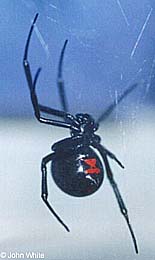Black Widow
| Black Widow Latrodectus Spiders from the genus Latrodectus are referred to as black widows, especially the species Latrodectus mactans. |
There are about six species found around the world and all of them are venomous. Their bites, however, are rarely fatal to humans.
|
| Latrodectus geometricus | Africa, U.S.A. |
| Latrodectus curacaviensis | Americas |
| Latrodectus hystrix | S Europe, N Africa, SW Asia |
| Latrodectus dahli | S Europe, N Africa, SW Asia |
| Latrodectus pallidus | S Europe, N Africa, SW Asia |
| Latrodectus mactans | U.S.A., warm regions worldwide |
Some species are terrestrial, others live in trees and in shrubs above the ground. There are some spiders that hide, more accurately live, under logs and stones in woods and fields. Latrodectus mactans is sometimes found in trash around the home.
The adult female Latrodectus mactans is 2-3 cm long and has a body length of 2-3 cm. It received this name (red-back spider) because of the distinctive red stripe on its abdomen. The male is seldom seen because the female eats him after mating. That is where the name black widow comes from. The male is about four times smaller than the female and is less dangerous. Besides the reddish hourglass-shaped design, it often has four pairs of reddish stripes on the sides of the abdomen. |
|
The black widow is not an aggressive spider. However, bites are not uncommon. The venom contains neurotoxins and soon after the bite an immediate strong pain is felt. The affected limb starts sweating. Systemic symptoms may develop if the bite is not treated immediately. These include nausea, vomiting, abdominal pain, pyrexia (fever) and in severe cases paralysis may occur.There is a specific red-back antivenin which is used when signs of systemic envenomation are observed. The pressure-immobilization method is not recommended since it can cause extreme pain in the affected area. Instead, ice packs could be used for relief.

